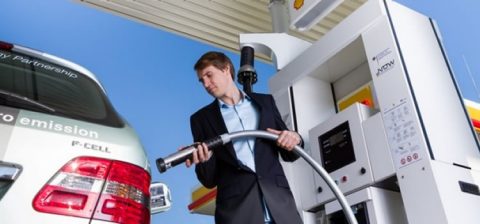
Shell bouwt in Duitsland honderden waterstoftankstations
14 oktober 2015 – Shell zet in Duitsland een netwerk op van honderden tankstations voor waterstofauto’s. Het eerste station bouwde Shell in 2011. Nu staan er drie, maar binnen acht jaar zal het netwerk zijn uitgebouwd tot maar liefst 400 tankstations.
Shell heeft het plan vastgelegd in een overeenkomst met de bondsregering en is met een aantal partners een joint venture (H2 Mobility Germany) gestart.
Ook Nederland staat op hert verlanglijstje van Shell.
Uit een persbericht van Shell
‘(…) “Hydrogen-fuelled electric vehicles could play a key part in a low-carbon, low-emission, future,” said Oliver Bishop, General Manager of Hydrogen at Shell. “It will take technical innovation and bold policies to transform the global energy system into a progressively cleaner, less carbon-intensive one. H2 Mobility Germany shows what we can achieve through close collaboration between governments and business. The next step is for consumers to embrace this opportunity and consider buying hydrogen vehicles as they become available.”
Shell currently operates three hydrogen stations in Germany, including one in Berlin and two in Hamburg. Shell anticipates the first four new fuelling points will be installed at existing retail sites in Frankfurt, Wuppertal, Geisingen and Wendingen.
The pumps at these sites will refuel hydrogen fuel cell electric vehicles (FCEV) in a few minutes. The cost of charging a hydrogen fuel cell vehicle is comparable to filling a car with gasoline or diesel and they can travel similar distances to vehicles with conventional combustion engines.
Shell has another two demonstration hydrogen filling stations in Los Angeles that allow the company to evaluate a range of technologies, drive down costs and better understand consumer behaviour.
The company is assessing the potential for more stations in the USA, UK, Switzerland, Austria, France, Belgium, the Netherlands and Luxembourg. (…)
About hydrogen
- Hydrogen fuel cell electric vehicles (FCEVs) convert hydrogen into electricity and produce only heat and water when driven. They offer an alternative to the conventional car, a driving experience similar to electric cars, and zero local emissions. They also offer the potential for zero CO2 emissions, depending on the electricity source.
- When hydrogen is produced from natural gas – the cleanest burning fossil fuel – it can greatly reduce well-to-wheel CO2 emissions compared to gasoline or diesel, due to the higher efficiency of the fuel cell drive train.
- The CO2 footprint of hydrogen produced from electricity (via electrolysis with water) depends on the CO2 intensity of the power source. Using electricity to make hydrogen though electrolysis could help absorb surplus wind and solar energy, at times of low power demand.
- Hydrogen mobility is a ‘chicken and egg’ situation. FCEVs will only be bought by customers if there is a refuelling infrastructure. Establishing and maintaining investment in fuelling infrastructure is only commercially attractive and sustainable if there are enough FCEV customers.
- If barriers can be overcome, FCEVs, along with electrification via plug-in hybrid and battery-electric vehicles, will make a material contribution to reducing emissions from road transport in the coming decades. (…)’
Bronnen
Shell, persbericht, 13 oktober 2015: Shell to install nationwide network of hydrogen vehicle fuelling pumps in German
Foto: Shell



